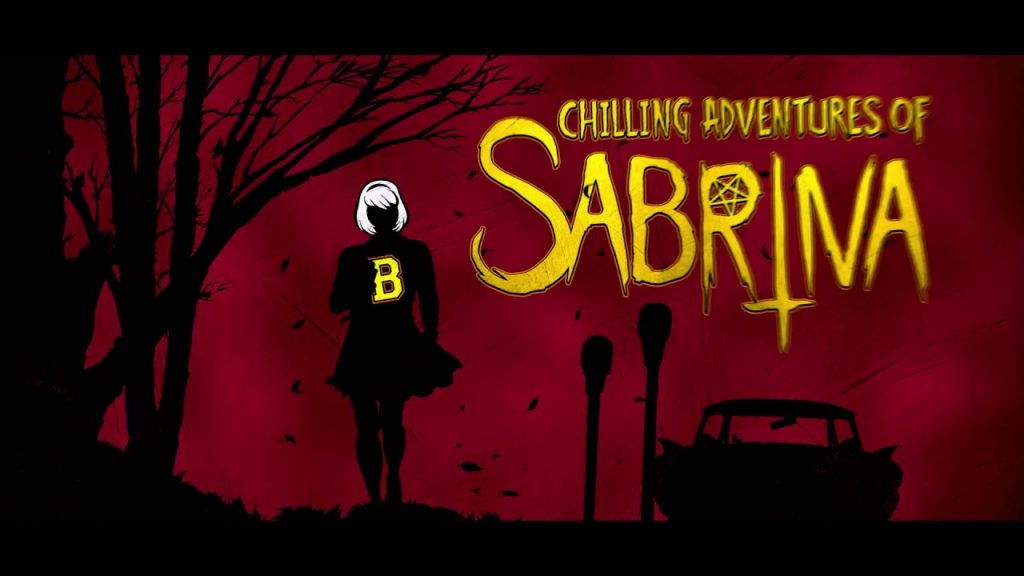The latest Netflix series, ‘The Chilling Adventures of Sabrina,’ which is touted as a revamp of the classic comic series, ‘Sabrina: The Teenage Witch,’ in the same vein as ‘Riverdale’ (the fictional hometown of the beloved Archie), showed some promise, when viewers were treated to a slick trailer in October, before the series’ premiere on the 30th that month (i.e. Halloween).
Sadly, the makers have reverted to offering an archetypal narrative riddled with tried and tested stereotypes, alluding to devil worship — a trope that has existed since the early years of cinema and television.
Presenting the world of magic and witchcraft as the realm of The Devil (called Dark Lord, Father of Lies, Satan, Lucifer, his oft-repeated epithets), the show fails to deviate from the infuriating norm that makes it appear regressive. Depicting Satan as a primary antagonist doesn’t help matters as it just makes one, who is tired of the same song and dance, want to roll his/her eyes due to the utter frustration that nothing new is offered here.
The complete and total absence of female divinities and the presentation of witch covens as organised religious Satanic bodies fails to do such a topic, which has the capability of being diverse, any kind of justice. That being said (or in this case written/typed), one must not lose hope entirely. There are indeed numerous delightful references, allusions and allegories for lovers of dark fantasy, myth and folklore. Kindly note that this is not intended to be a critique or attack on religious symbolism and beliefs or as a definitive list of references. Do read with an open mind and enjoy the proverbial ride…
* One needs to look no further than at the Sabrina logo, after the opening credits end. A downwards pointing pentagram and an inverted crucifix/holy cross are designed into the words Sabrina. The pentagram, a sacred geometric symbol traditionally attributed to represent the five wounds of Jesus Christ in Christianity, has been used as a symbolic allegory to denote neo-pagan beliefs and practices and in some notable cases modern Satanism itself. But, over the years, it has come to represent and be associated with the pagan world, especially witchcraft (Note: Wicca), which in itself, purports a belief system based entirely on the worship of nature, especially the elements.
The Inverted Crucifix/Cross also known as Petrine Cross, is actually a strong Christian symbol. Legend has it that St. Peter requested to be crucified upside down, reasoning that he didn’t think it would be appropriate to be hung in the same manner as Jesus Christ. It was later adopted by Anti-Christians as a motif designating its opposing nature to Christ, becoming an anti-thesis to Christianity in the process and has been portrayed as such in mass media in the following years. One can also interpret it as a symbol of anti-authority or anarchy.
* Sabrina Spellman (Kiernan Shipka) plays the cliched role of the mixed heritage protagonist (a half-witch in this case, born to a human mother and a warlock (male-witch) father, who was the high-priest of his coven). She is forced to make a choice, a difficult life decision, a plot element, which has been part of numerous fantasy narratives as far as the genre at hand is concerned. Portrayed as a literal ‘Little Red Hiding Hood’ (accentuated by the red coat, which is part of her costume in the series), Sabrina courts danger at every turn aided by supernatural beings and entities. While this in itself doesn’t necessarily steer the ship into fresh but uncharted waters, her typical characterisation to suit the limits of conventional storytelling is complete.
* The Dark Baptism, a supposedly demonic variation of a rite of passage, a coming-of-age ritual, where Sabrina, donning a wedding dress (which magically transforms into black), is forced to write/register her name in the ‘Book of the Beast’ (The Beast: another biblical name of Satan). Her forehead is adorned with the blood of a sacrificed ram during the metaphorical courting and matrimonial union with the Devil. The aforementioned ceremony (which turns out to be unsuccessful as Sabrina refuses to sign her name in the book), was exactly what the women accused of being witches during the historical Salem Witch Trials were believed to have allegedly done — participated in an unholy ritual desecration to proclaim their allegiance to dark Satanic forces.
The ram’s sacrifice mirrors what the Greek/Roman mythological hero Odysseus or Ulysses (of Homer’s epic poem The Odyssey) performed to obtain answers from the Oracle of the dead, a common occurrence in such myths.
* In fact the name of one of the characters Dr. Cerberus, is a nod to the three-headed guardian hound of the Greek God Hades, the king of the underworld. Cerberus the dog also interestingly makes an appearance in the book and film, ‘Harry Potter and the Philosopher’s Stone.’
* The use of animal familiars by witches and warlocks in ‘The Chilling Adventures of Sabrina’ is a reference to folklore popularising supernatural animal helpers. Cats (Salem returns!), spiders, lizards, ravens, mice and other creatures are liberally interwoven in the episodes, which loosely alludes to the nature spirit theory, a common feature in Celtic and Japanese Mythology in particular, but has been included in the myths and legends of other countries, especially India. In Sabrina, these animal helpers/familiars are shown to be hideous goblins in their true form and are unable to live without their masters, just as their origin-stories suggest.
* The Weird Sisters are a reference to the three witches in William Shakespeare’s play ‘Macbeth’ cast spells and prophesy at important points during the proceedings. The famous passage ‘Double Double, Toil and Trouble, Fire Burn and Cauldron Bubble’ that the witches chant at the play’s beginning was reworked for the film ‘Harry Potter and the Prisoner of Azkaban’ (2004). The band ‘Weird Sisters’ in the ‘Harry Potter’ books and films was inspired from ‘Macbeth’ as well.
* Mrs Wardwell/Madam Satan calls herself Lilith, the mother of demons and the first wife of Adam. Lilith, a prominent figure in Jewish folklore, was created by God, after Adam in the same humble clay before Eve, according to some sources. Legend has it that she refused to be subservient to Adam and even demanded to be the dominant partner during sexual intercourse. One story suggests that she obtained this attitude after indulging in sexual relations with the angel Samael. Some tales show her uttering Jehovah’s name (Yahweh in some texts), which causes her to develop supernatural powers, after which she becomes a demonic entity known for kidnapping babies at night. The term lullabye, a song sung by mothers to induce sleep in their children, traces its origins from ‘Lilith-go-bye’ as it is believed to ward Lilith off and keep her away.
* Daniel Webster is modernised for 2018’s audiences in ‘The Chilling Adventures of Sabrina’ and much like his counterpart in ‘The Devil and Daniel Webster’ a 1936 short story, where the titular Webster, a lawyer based on the famous historical figure of the same name, defends a New Hampshire farmer, who sold his soul to the Devil and wins.
* When Ambrose Spellman expresses his interest to go on a date with fellow warlock Luke through Astral Projection with the help of his Aunt Hilda, she warns him of the Psychopomps (as his soul will be in limbo, a place between the living world and the afterlife), who are basically spiritual entities, who ferry the souls of the dead to the underworld. Their depiction as sparrows isn’t exactly atypical. Most notable Psychopomps in myths are the Gree k god Hermes, also known as Mercury and the Lord Yama, the ruler of the Hindu underworld.
* The biblical story of Cain and Abel has been given a twist on the show, when Zelda, who is being terrorised by the sleep demon Batibat, dreams a version of the tale, with her playing Abel to her sister Hilda’s Cain. Satan is re imagined in the role of the Christian god Jehovah/Yahweh in this case.
* Sabrina Spellman attempts to bring back her boyfriend’s brother Tommy back to life through the practice of Necromancy, an ancient magical ritual involving the dead, in which practitioners would attempt to summon the spirits of departed persons or even try their hand at resurrection mostly to horrible results.
* The sleep demon Batibat, who terrorises Sabrina and her family members, is an actual deity in the pantheon of Ilocano folklore prominent in the Philippines. Residing in trees in the form of a huge, old fat woman, the Batibat comes into contact with humans if the tree it inhabits is chopped and made into a house’s support post. They possess the post and attacks people, who sleep near it. Anyone, who slumbers near the post with a Batibat as its occupant, will be suffocated to death by the creature as it will sit upon their chest until they pass away.
* Sister Freya, in whose honour, the Feast of Feasts is held every year, according to the show, takes her name from the Norse Mythological goddess Freya. Freya, was part of a tribe of Gods known as the Vanir, who possessed expertise in withcraft and sorcery. But, as per the series of events in the myths, following the Aesir-Vanir war, in which the chief gods of the Norse Pantheon clashed with the Vanir, she became a honorary member of the Aesir, the rulers of Asgard (this can be compared with Mount Olympus in the Greek Myths, or Devlok in Hindu Mythology)
* The ghastly practice of ritualistic cannibalism (don’t know how the makers got away with this), shown during the Feast of Feasts, is not exactly an unknown practice and is actually prevalent in some cultures, albeit in a clandestine way.
* During the chants of the exorcism ritual, where Sabrina, Madam Satan and aunts Hilda and Zelda attempt to exorcise Susie’s uncle Jesse, who is possessed by the demon Apophis, numerous famous female figures from history and myths are mentioned including Lilith, Aradia, Morgan Le Fay, Anne Boleyn, With of Endor, Hecate, Artemis, Hildegard, Tituba, Mary Bradbury, Circe, Juventus the Virgin, among others
* Academy of Unseen Arts: This cliched representation of a so-called Hogwarts-like school of witchcraft and wizardry, is quite typical of such shows. Showing, the statue of Baphomet, doesn’t help matters either, with the makers even getting in trouble with the Satanic Temple representatives over its depiction. Also, the ghost Quentin mentions the structure of the school building has been designed as per sacred geometrical figures like the Pentagram. The practice of harrowing and the depiction of the hung witches, all are mostly nods to the Salem Witch Trials
* High priest Father Blackwood’s first name is Faustus, which might be a reference to the protagonist of the classic German legend, Faust, which was based on the historical Renaissance man Johann Georg Faust, who was also known as John Faustus. The tale shows an erudite but dissatisfied Faust make a pact with the Devil, or specifically his representative, the demon Mephistopheles, which involves him offering his soul in return to unlimited knowledge and worldly pleasures
* In a conversation with Father Blackwood, the pansexual warlock Ambrose Spellman claims he was influenced by a young Aleister Crowley to participate in a plot to blow up the Vatican. Crowley was a controversial figure, who donned many hats. Born Edward Alexander Crowley, he was an English occultist, ceremonial magician, poet, painter, novelist, and mountaineer, who founded the religion of Thelema, identifying himself as the prophet entrusted with guiding humanity into the Æon of Horus in the early 20th century. His pagan beliefs didn’t sit well with English society during his lifetime, and his practices and beliefs were vilified as witchcraft and Satanic rituals by his naysayers.
* The Egyptian deity Apophis is re-imagined as a demon from the Christian conception of Hell in ‘The Chilling Adventures of Sabrina.’ In the world of Egyptian Mythology, Apophis or Apep, who has been portrayed in art as a giant serpent is considered the embodiment of chaos and therefore is the opponent of light and Ma’at (order/truth). Apophis has constantly clashed with the sun god Ra in several tales from Ancient Egypt, most notably illustrated in the works of author Roger Lancelyn Green.


















